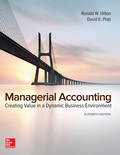
Consolidated Industries is studying the addition of a new valve to its product line. The valve would be used by manufacturers of irrigation equipment. The company anticipates starting with a relatively low sales volume and then boosting demand over the next several years. A new salesperson must be hired because Consolidated’s current sales force is working at capacity. Two compensation plans are under consideration:
Plan A: An annual salary of $22,000 plus a 10% commission based on gross dollar sales.
Plan B: An annual salary of $66,000 and no commission.
Consolidated Industries will purchase the valve for $50 and sell it for $80. Anticipated demand during the first year is 6,000 units. (In the following requirements, ignore income taxes.)
Required:
- 1. Compute the break-even point in units for Plan A and Plan B.
- 2. What is meant by the term operating leverage?
- 3. Analyze the cost structures of both plans at the anticipated demand of 6,000 units. Which of the two plans has a higher operating leverage factor?
- 4. Assume that a general economic downturn occurred during year 2, with product demand falling from 6,000 to 5,000 units. Determine the percentage decrease in company net income if Consolidated had adopted Plan A.
- 5. Repeat requirement (4) for Plan B. Compare Plan A and Plan B, and explain a major factor that underlies any resulting differences.
- 6. Briefly discuss the likely profitability impact of an economic recession for highly automated manufacturers. What can you say about the risk associated with these firms?
1.
Calculate the break-even point (in units) for plan A and plan B.
Explanation of Solution
Break-Even Point: It is the point of sales at which entity neither earns a profit nor suffers a loss. It can also be said that the point of sales at which sales value of the entity recovers the entire cost of fixed and variable nature is called break-even point.
Calculate the break-even point for plan A.
Working note:
Calculate the unit contribution margin.
| Particulars | Amount ($) |
| Sales | $80 |
| Less: | |
| Commission expenses | 8 |
| Variable cost | 50 |
| Unit contribution margin | $22 |
Table (1)
Calculate the break-even point for plan B.
Working note:
Calculate the unit contribution margin.
2.
Explain the operating leverage.
Explanation of Solution
Operating leverage: Operating leverage measures the proportion of fixed cost on the total costs and the extent to which the changes in the sales volume affects the income from operations. It shows the relationship between the contribution margin and income from operations.
The formula to calculate the operating leverage is as follows:
3.
Calculate operating leverage factor for Plan A and Plan B. Identify the plan that has a higher operating leverage factor.
Explanation of Solution
Calculate the operating leverage factor for plan A.
Calculate the operating leverage factor for plan B.
Plan B has a higher operating leverage factor of 1.58.
Working note:
Calculate the contribution margin and profit at 6,000 units.
| Particulars | Plan A | Plan B |
| Sales revenue: (a) | $480,000 | $480,000 |
| Less: | ||
| Variable cost: | ||
| Cost of purchasing product (b) | $300,000 | $300,000 |
| Sales commissions (c) | 48,000 | 0 |
| Contribution margin | $132,000 | $180,000 |
| Fixed cost | 22,000 | 66,000 |
| Net income | $110,000 | $114,000 |
Table (2)
- (a) Calculate the sales revenue.
- (b) Calculate the cost of purchasing product.
- (c) Calculate the sales commission.
4
Calculate the percentage of decrease in net income (plan A) due to decrease in number of units sold.
Explanation of Solution
Calculate the percentage of decrease in net income.
Working notes:
Calculate the profit for 5,000 units.
| Particulars | Plan A |
| Sales revenue: (a) | $400,000 |
| Less: | |
| Variable cost: | |
| Cost of purchasing product (b) | $250,000 |
| Sales commissions (c) | 40,000 |
| Contribution margin | $110,000 |
| Fixed cost | 22,000 |
| Net income | $88,000 |
Table (3)
- (a) Calculate the sales revenue.
- (b) Calculate the cost of purchasing product.
- (c) Calculate the sales commission.
5.
Calculate the percentage of decrease in net income (plan B) due to decrease in number of units sold.
Explanation of Solution
Calculate the percentage of decrease in net income.
Working notes:
Calculate the profit for 5,000 units.
| Particulars | Plan A |
| Sales revenue: (a) | $400,000 |
| Less: | |
| Variable cost: | |
| Cost of purchasing product (b) | $250,000 |
| Contribution margin | $150,000 |
| Fixed cost | 66,000 |
| Net income | $84,000 |
Table (4)
- (a) Calculate the sales revenue.
- (b) Calculate the cost of purchasing product.
If the company adopts the plan B, it experiences a higher percentage decrease in income. This is because plan B has a high operating leverage factor.
6.
Explain about the risk associated with highly automated manufactures due to the economic recession.
Explanation of Solution
Highly automated manufacture will have a large investment in plants and equipment, along with higher percentage for fixed cost in their cost structure. Therefore, they will have a high degree of operating leverage.
During the economic recession, these firms suffer a decrease in profitability. These firms are more risky to invest than the firms having a low degree of operating leverage. When, times are good, the firm’s sales will increase and have a favorable effect on earnings with high operating leverage.
Want to see more full solutions like this?
Chapter 7 Solutions
Managerial Accounting: Creating Value in a Dynamic Business Environment
 Cornerstones of Cost Management (Cornerstones Ser...AccountingISBN:9781305970663Author:Don R. Hansen, Maryanne M. MowenPublisher:Cengage Learning
Cornerstones of Cost Management (Cornerstones Ser...AccountingISBN:9781305970663Author:Don R. Hansen, Maryanne M. MowenPublisher:Cengage Learning
